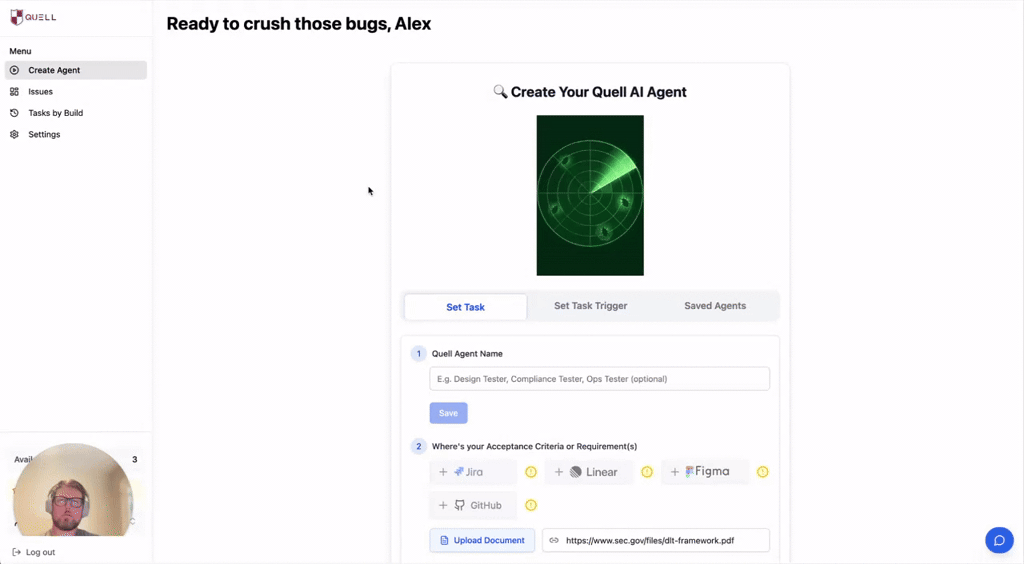
Table of Contents
Overview
In today’s rapid development cycles, ensuring every build meets its acceptance criteria is critical. Quell’s UAT AI agents automate user acceptance testing, pinpoint critical issues, and confirm that deployments on Vercel or Netlify align with acceptance criteria drawn directly from Linear issues, Jira tickets, or Figma designs. When discrepancies arise, Quell goes beyond flagging them—it automatically creates and files detailed tickets to keep your QA workflow moving.
Key Features
Quell’s platform offers a suite of capabilities crafted to transform how teams handle acceptance testing:
- Automated UAT agents: Launch AI-driven agents that simulate real user interactions and run acceptance tests without manual intervention.
- Integration with Jira, Linear, Figma, GitHub, Slack, and more: Pull acceptance criteria straight from your project and design tools to ensure tests always reflect the latest requirements.
- Vercel and Netlify deployment hooks: Embed Quell into your CI/CD pipeline so tests trigger automatically after each new build.
- Bug detection and reporting: Use AI to detect critical defects and deviations from design specs, then surface concise failure details for rapid triage.
- Derived test scenarios: Generate preliminary test scenarios from linked design documents and issue tickets, reducing the time spent drafting test cases.
- Ticket creation automation: When an issue is detected, Quell crafts and files a rich ticket—complete with reproduction steps and context—into your issue tracker.
How It Works
Quell connects to your deployment workflow in minutes. After linking to your Vercel or Netlify account and granting access to your issue tracker and design sources, Quell’s agents automatically pull in acceptance criteria. On every new build, the agents execute tests based on those criteria. If any checks fail, Quell instantly files a ticket in your chosen tracker with all relevant details, allowing developers to address issues without leaving their existing workflow.
Use Cases
Quell’s UAT AI agents adapt to a variety of testing scenarios:
- Frontend web app acceptance testing: Verify that UI components and flows match design intent and functional requirements before release.
- Continuous deployment validation: Automatically validate every build in your CI/CD pipeline, ensuring that no changes slip through untested.
- Regression detection: Rerun acceptance tests on each new deployment to catch reintroduced bugs early.
- QA automation for SaaS teams: Reduce manual testing effort so teams can accelerate release cadences with confidence.
- Design-to-production verification: Confirm that production code faithfully implements the original Figma designs and documented criteria.
Pros \& Cons
Quell delivers significant benefits but also has some considerations to weigh.
Advantages
- Reduces manual QA workload: Automates repetitive acceptance tests so QA engineers can focus on exploratory testing and edge cases.
- Deep toolchain integration: Links seamlessly with Jira, Linear, Figma, GitHub, Slack, and more to keep acceptance tests in sync with your source of truth.
- Accelerates release cycles: Proactive bug detection and automated ticket filing help teams ship high-quality software faster.
Disadvantages
- Limited to supported integrations: Full automation requires connections to Jira, Linear, Figma, Vercel, or Netlify.
- May need customization for complex workflows: Highly specialized applications might require fine-tuning of test scenarios and acceptance criteria.
- Emerging platform: As a newer solution, some advanced features—such as custom analytics dashboards—are still rolling out.
How Does It Compare?
When placed alongside other testing solutions, Quell’s design-driven UAT focus stands apart:
- Reflect: Excels at visual regression testing but offers fewer direct hooks into design files for deriving acceptance criteria. Quell’s strength is in translating design specs into actionable tests.
- Waldo: Specializes in mobile app testing on real devices, whereas Quell targets web-based UAT and end-to-end acceptance flows for frontend applications.
- Testim.io: Provides a broad enterprise automation suite, but Quell uniquely links tests directly to project management items and design documents for precise acceptance testing.
Final Thoughts
Quell’s UAT AI agents bridge the gap between design, development, and QA by automating acceptance testing end to end. Teams leveraging Vercel or Netlify deployments and tools like Jira, Linear, and Figma will find that Quell streamlines QA workflows, surfaces issues proactively, and accelerates release velocity. While integrations and advanced analytics continue to evolve, Quell already delivers a powerful, design-to-test automation engine that can save teams countless hours of manual effort. For any organization aiming to enforce acceptance criteria rigorously without slowing down, Quell is a compelling solution worth exploring.

